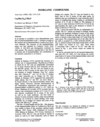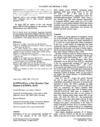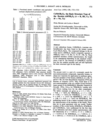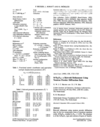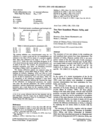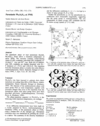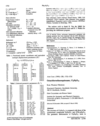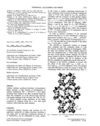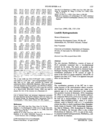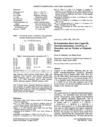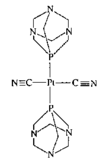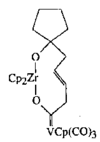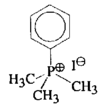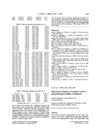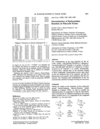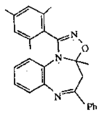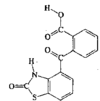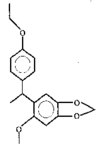issue contents
September 1995 issue

Cover illustration: Two New Scandium Phases: ScSn2 and Sc6Pb5, see Pani, Manfrinetti & Fornasini, pages 1725-1728. Projection of the structures of ScSn2 and ZrSi2 along [100] (left) and Sc tetragonal antiprisms centred by Pb atoms and Pb octahedra centred by Sc atoms in the structure of Sc6Pb5 (right).
inorganic compounds
Download citation


Download citation


The structure of Cs6[Mo7O24].7H2O contains 9- 10- and 11-coordinate Cs+ cations bound to terminal, doubly bridging and quadruply bridging O atoms of the polyanions, as well as to water molecules.
Download citation


Download citation


Substitution of 2Ti4+ in the structure of KTiOPO4 (KTP) by Ni2+ and W6+ leads to the new non-centrosymmetric compound K2NiWO2(PO4)2 (KNiWP). The structures of KTP and KNiWP are closely related.
Download citation


Download citation


The crystal structure of CsNbOB2O5 represents the basic structure type of the borate family AMOB2O5 with A = K, Rb, Cs, Tl and M = Nb, Ta. The structure contains untilted chains of [NbO6] octahedra linked by planar [B2O5] groups. Cs is coordinated irregularly by eight O atoms.
Download citation


Download citation


The structure of SrTa4O11 contains layers of TaO7 pentagonal bipyramids sharing edges, as found in U3O8. Between the layers lie Sr atoms with distorted cubic coordination geometry and Ta atoms with distorted octahedral coordination geometry.
Download citation


Download citation


The structure of ScSn2 is related to the ZrSi2 structure type and contains slabs of Sc trigonal prisms centred by Sn. Sc6Pb5, isotypic with Ti6Ge5, is characterized by infinite columns of Sc tetragonal antiprisms centred by Pb and by infinite columns of Pb octahedra centred by Sc atoms.
Download citation


Download citation


The outstanding features of this new vierer single-chain silicate are the large stretching factor of the silicate chain of fs = 96.8%, a very small Si-O-Si angle of 118.3° and the presence of three-membered rings formed from two [SiO4] and one [ZnO4] tetrahedra.
Download citation


Download citation


Pb5Al3F19 undergoes three phase transitions between 80 and 400K. The structure at 370K contains corner-sharing AlF6 octahedra and individual AlF6 octahedra. The Pb atoms occupy tunnels of 2.5Å radii.
Download citation


Download citation


The cage compound Cl8Si8O12 shows a close structural resemblance to the compound (CH3)8Si8O12. As a result of interelectronic repulsion and the considerable electronegativity of the Cl substituent, distortions of the tetrahedral Si environment and a shortening of the Si-O bond occur.
Download citation


Download citation


Li1.14Nb0.93Sc0.67Cr0.40P3O12 is the first example of a Nasicon-type compound containing a pentavalent cation. The [M2(PO4)3] framework contains double [M(1)M(2)P3O18] units which share apical O atoms to form a three-dimensional network.
Download citation


Download citation


The structure of Pb(HSeO3)2 consists of layers of Pb-O polyhedra and selenite groups. The coordination polyhedron of Pb is a square antiprism.
Download citation


Download citation


Analysis of previously published diffraction data shows that Cu(AlCl4)2 is monoclinic. Refinement on this basis gives an improved R factor. The changes in the structure are small.
metal-organic compounds
Download citation


Download citation


Download citation


Download citation


Download citation


Download citation


Download citation


Download citation


Download citation


Download citation


Download citation


Download citation


Download citation


Download citation


Download citation


Download citation


Download citation


Download citation


Download citation


Download citation


Download citation


Download citation


Download citation


Download citation


Download citation


Download citation


Download citation


Download citation


Download citation


Download citation


Download citation


Download citation


Download citation


Download citation


Download citation


Download citation


Download citation


Download citation


Download citation


Download citation


Download citation


Download citation


Download citation


Download citation


Download citation


Download citation


Download citation


Download citation


Download citation


Download citation


Download citation


Download citation


Download citation


Download citation


Download citation


Download citation


Download citation


Download citation


Download citation


Download citation


Download citation


Download citation


Download citation


Download citation


organic compounds
Download citation


Download citation


Download citation


Download citation


Download citation


Download citation


Download citation


Download citation


Download citation


Download citation


Download citation


Download citation


Download citation


Download citation


Download citation


Download citation


Download citation


Download citation


Download citation


Download citation


Download citation


Download citation


Download citation


Download citation


Download citation


Download citation


Download citation


Download citation


Download citation


Download citation


Download citation


Download citation


Download citation


Download citation


Download citation


Download citation


Download citation


Download citation


Download citation


Download citation


Download citation


Download citation


Download citation


Download citation


Download citation


Download citation


Download citation


Download citation


Download citation


Download citation


Download citation


Download citation


Download citation


Download citation


Download citation


Download citation


Download citation


Download citation


Download citation


Download citation


Download citation


Download citation


Download citation


Download citation


Download citation


Download citation


Download citation


Download citation


Download citation


Download citation


Download citation


Download citation


Download citation


Download citation


Download citation


Download citation


Download citation


Download citation


Download citation


Download citation


Download citation


Download citation


Download citation


Download citation


Download citation


Download citation


Download citation


Download citation


Download citation


Download citation


Download citation


Download citation


Download citation


Download citation


Download citation


Download citation


Download citation


Download citation


Download citation


Download citation


Download citation


Download citation


Download citation


Download citation


Download citation


Download citation


Download citation


Download citation


Download citation


Download citation


Download citation


Download citation




 journal menu
journal menu











